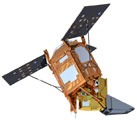The Copernicus Sentinel-5 Precursor mission is the first Copernicus mission dedicated to monitoring our atmosphere. Copernicus Sentinel-5P is the result of close collaboration between ESA, the European Commission, the Netherlands Space Office, industry, data users and scientists. The mission consists of one satellite carrying the TROPOspheric Monitoring Instrument (TROPOMI) instrument. The TROPOMI instrument was co-funded by ESA and The Netherlands.
The main objective of the Copernicus Sentinel-5P mission is to perform atmospheric measurements with high spatio-temporal resolution, to be used for air quality, ozone & UV radiation, and climate monitoring & forecasting.
The satellite was successfully launched on 13 October 2017 from the Plesetsk cosmodrome in Russia.
The satellite's local time of ascending node crossing of 13.30 h has been chosen to facilitate the so-called loose formation operation with NASA's Suomi-NPP spacecraft. This concept will allow the utilization of co-located, high resolution cloud mask data provided by the VIIRS (Visible Infrared Imaging Radiometer Suite) instrument on-board Suomi-NPP during routine processing of the TROPOMI methane product.
The Copernicus Sentinel-5 Precursor mission reduces gaps in the availability of global atmospheric data products between SCIAMACHY/Envisat (which ended in April 2012), the OMI/AURA mission and the future Copernicus Sentinel-4 and Sentinel-5 missions.
The TROPOMI instrument combines the strengths of SCIAMACHY, OMI and state-of-the-art technology to provide observations with performances that cannot be met by the current instruments in space. Performance of current in-orbit instruments are surpassed in terms of sensitivity, spectral resolution, spatial resolution and temporal resolution.
Copernicus Sentinel-5 Precursor Data Provision Plan and actual product releases to the public during the ramp-up phase:
- Launch +8 months - Level-1B; Total Columns of Ozone (Near Real Time production), Nitrogen Dioxide, Carbon Monoxide; Cloud & Aerosol information => data released on 10 July 2018
- Launch +10 months - Total Columns of Ozone (Offline production), Formaldehyde, Sulphur Dioxide ==> data released on 17 October 2018
- Launch +12 months - Total Columns of Tropospheric Ozone, Total Columns of Methane ==> data released on 1 March 2019.
The Copernicus Sentinel-5 Precursor ramp-up phase ended on 5 March 2019 and since this time the mission is in routine operations phase. The public release of the Aerosol Layer Height product took place during September 2019 and the release of the Ozone Profile during November 2021.
Level 1B and Level 2 products are available via the Copernicus Data Space Ecosystem.
Level 1B and Level 2 user documentation is available in the Products and Algorithms Technical Guide.
Key users of the Copernicus Sentinel-5 Precursor products are Copernicus services such as the ‘Copernicus Atmosphere Monitoring Service' (CAMS) or the ‘Copernicus Climate Change Service' (C3S). Decision makers will use the information provided by these services in order to take the right actions on environmental policies from which depends the well-being and security of EC citizens and future generations.
Basic information about the Copernicus Sentinel-5 Precursor mission:
- Overview
A brief description of the heritage missions and the main thematic areas and services (e.g. air quality, climate, ozone). - Satellite Description
A description of the satellite platform and communication links, orbit characteristics, and geographical coverage. - Ground Segment
Descriptions of the Flight Operations Segment (FOS) and the Payload Data Ground Segment (PDGS). - Instrumental Payload
A description of the Copernicus Sentinel-5P mission instrumentation: TROPOMI. - Data Products
Definitions of all data products available for the TROPOMI instrument. - Mission Status
biweekly reports providing information on the status of the satellite and the TROPOMI instrument. - Commissioning/Ramp-up Phase
Describing the Commissioning/Ramp-up phase milestones.
